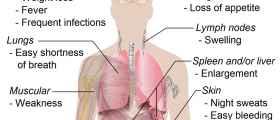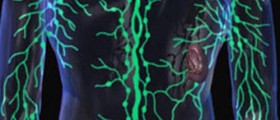
Non-Hodgkin lymphoma together with Hodgkin lymphoma belongs to a group of lymphomas which are malignant cancers of lymphatic system. Non-Hodgkin lymphoma originates from lymphocytes. These cells start to multiply without any limitation and lead to formation of lumps. There are 16 types of Non-Hodgkin lymphomas. The definitive diagnosis can be set when the malignant tissue is pathologically examined. This way the differential diagnosis between Hodgkin and Non-Hodgkin lymphoma is set.
Localization of the Disease
Since lymphatic tissue is present in the entire body this means that lymphomas can develop wherever this tissue is. Non-Hodgkin lymphoma may affect lymph nodes. However this disease mainly present with the formation of lumps outside lymph nodes and is then classified as extranodal Non-Hodgkin disease. The predilection places may include bone marrow, stomach, small intestines, and testicles. Any part of the body can be affected.
Symptoms
The problem of this tumor is that it features with production of immature forms of lymphocytes. This way they are not fully developed and cannot fight against the infection properly. The majority of symptoms are related to this fact. People suffering from lymphomas are prone to infections more and they cope with them with more effort. However some other symptoms are caused by direct impact of the tumor tissue on the surrounding structures.
The disease may start with enlarged lymph nodes in armpits, groins or neck. The enlargement last longer that in some other conditions such as viral infections. Therefore if lymph nodes tend to be huge for at least six weeks one should go visit a doctor.
There are some general symptoms common to both Hodgkin and Non-Hodgkin lymphomas. This includes in increased body temperature, extensive perspiration especially during night and drastic loss of weight. Some patients complain about increased itch of the skin. Sometimes there is even skin rash.
Additional symptoms are related to the very location of the tumor. They may present with enlarged liver or spleen. Tonsils can get bigger as well if occupied by tumor tissue. Problems with intestines such as pain in abdomen constipation etc. may point to presence of lumps in abdomen. In case of the tumor presence within chest cavity respiratory symptoms such as difficulties with breathing occur.
If the tumor has affected bone marrow a patient will suffer from inappropriate production of blood cells. One may suffer from anemia infections and problems with coagulation (low account of platelets).
In worst cases even brain may show the signs of the disease. This form of lymphoma is rather rare but still possible. It presents with headaches, problems with thinking and memory. If large masses are present in the brain paralysis as well as seizures occurs.
















Your thoughts on this
Loading...